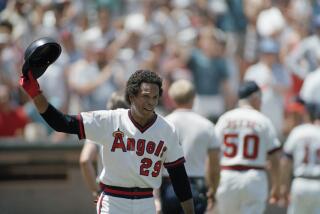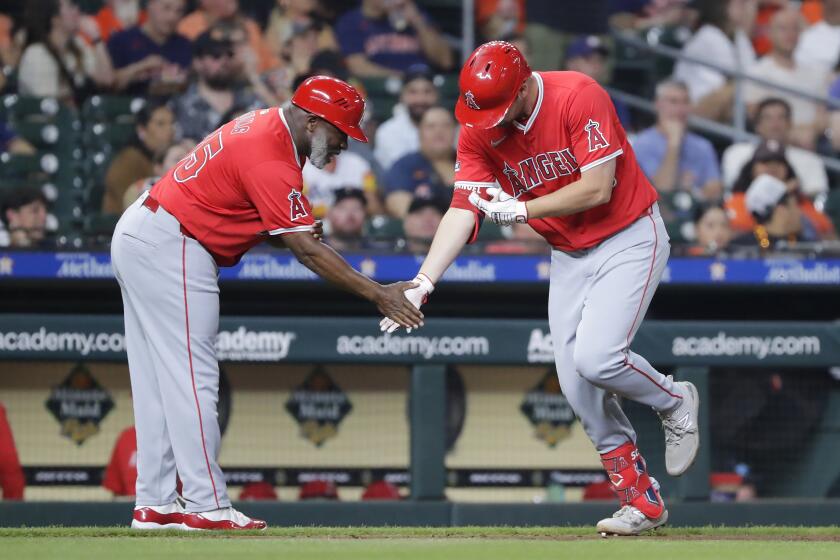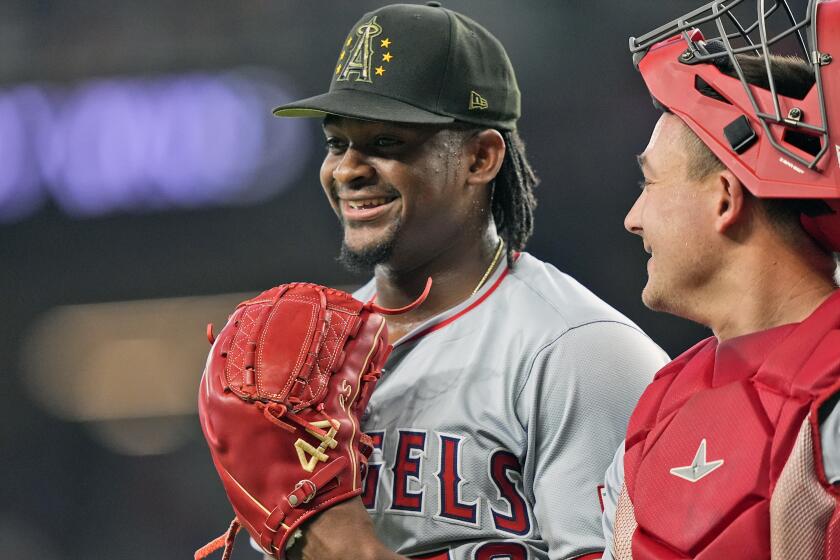Diamonds in the Rough
While 40 players in the Angels’ baseball academy go through their daily boot camp-like regimen of drills and games, the pobrecitos, the poor boys, angle for odd jobs in hopes of earning a plate of leftovers, a baseball or a few pesos.
The players can’t help but notice kids such as Jonas DeLeon, a shirtless, shoeless 10-year-old with a mischievous grin and inquisitive eyes. After cleaning cleats for an hour, the miniature Doc Gooden look-alike is rewarded with some chicken, rice and beans, courtesy of a third baseman.
“When I see them, it hurts my heart,” said Angel pitching prospect Daniel Arias, thumping his chest with a fist. “When I see them around, it makes me play stronger because I want to be able to help them. . . . I want to succeed for them too.”
The little boys motivate the big boys here because in these kids, the Angel prospects, who range in age from 16 to 21, see themselves.
Most of the players grew up the same as Jonas, with little money and dreams of being the next Sammy Sosa or Pedro Martinez, national icons who fuel baseball’s fervor on this small island of 8 million people that churns out big leaguers like sugar cane.
Here, there is more than a passion for baseball. There is a hunger, a feeling among young men and boys that the sport is the best path toward prosperity.
That’s why the Angels, after virtually neglecting this talent-rich region for more than a decade, have immersed themselves in Latin America in the last year and a half. By pumping millions into their development budget and upgrading their Dominican facility, which houses players from throughout the region, they hope to land a superstar such as Vladimir Guerrero or Raul Mondesi, or a rising prospect such as Ramon Ortiz. All at a fraction of the cost it would take to sign a player from the U.S.
For roughly what the Angels spent to sign first-round pick Joe Torres, a Florida high school pitcher who received $2.08 million last June, they can fund the entire Latin American program for a year, including salaries for scouts, academy operating expenses and player signings.
In recent years, some Latin players have found better representation and commanded huge bonuses, but most sign for less than $20,000, bargain prices for teams looking to contain costs.
Critics worry that baseball is exploiting Latin players, most of whom aren’t eligible for the annual amateur draft. But in countries such as the Dominican, where the per-capita income is $1,600, a $5,000 bonus can constitute several years’ income, and players jump at the chance to make far more in the U.S.
“Baseball was everything for me as a kid--it was all I ever thought about and dreamed about,” said Junior Guzman, a catcher in the Angels’ academy. “It’s a big opportunity to play here, but the biggest opportunity is to be able to play in the U.S. and in the big leagues, because then you can take care of your family for life.”
It doesn’t matter that 90-95% of foreign-born players are released while still in the minors. From the time kids can whack a wad of tape with a stick, their goal is to play in las grandes ligas--the big leagues.
“Boys don’t play baseball here just for recreation,” said Rafael Lora, 35, a coffee bean farmer from the northern city of San Francisco de Macoris. “They play it for survival.”
Bargain Hunters
Scouts sift through this baseball-happy island as if they were mining for gold, and for good reason.
Many of the game’s brightest stars are from Latin America. Of the 839 players (750 active and 89 disabled) on major league opening-day rosters last season, 175 were from Latin America and the Caribbean, 71 of them, or 8 1/2%, from the Dominican.
The competition for players has grown so fierce that every big league club--and Japan’s Hiroshima Carp--has an academy or program in the Dominican.
Concerned about exploitation of players and rules violations among U.S. clubs pursuing less-expensive Latin talent, major league baseball is considering a worldwide draft, and recently opened an office in the Dominican.
Latin players have become part of American baseball’s fiber, but only 63 have played for the Angels in their 40-year World Series-less history.
Of those, the club signed or drafted only 22, none of whom became stars.
And while the Dodgers were busy gaining a foothold in the region, and grooming such players as Mondesi, brothers Pedro and Ramon Martinez and Adrian Beltre at their sprawling, resort-like academy, the Angels went 10 years without a home-grown Latin player on their big league roster. After Urbano Lugo and Gus Polidor in 1988 there was a void until Puerto Rican catcher Bengie Molina came along in 1998.
Jose Gomez, a former Angel scout who ran the Angels’ Dominican summer league team for several years in the 1990s, recalls asking then-general manager Mike Port for $20,000 to renovate the field in 1991.
“He said the Angels didn’t have any money,” Gomez said. “Then they gave Chuck Finley $18 million [in a four-year deal].”
The Angels ran an academy here for the three-month summer league from 1988-91, but the budget-cutting Autry family shut down the facility in 1992 and ’93 and rented it to Tampa Bay in ’94.
The Angels reclaimed the academy--their only Latin American outpost--and fielded a summer league team in 1995, but their presence was minimal.
It wasn’t until 17 months ago that the Angels made a full-body plunge into Latin America, under the direction of General Manager Bill Stoneman, scouting director Donny Rowland and international scouting director Clay Daniel.
Since Stoneman took over on Nov. 1, 1999, the Angels have signed 47 players from Latin America at a cost of about $1.5 million, with pitchers Johan Quezada Santana ($700,000) and Hector Benoit ($325,000) accounting for most of that expenditure.
Their academy, run by former minor league instructor Charlie Romero, is now a 10-months-a-year operation, with 75 games in the summer and 65 in the winter, an ambitious schedule that brings them into line with other clubs.
The Angels have four scouts in the Dominican, two in Venezuela, one in Puerto Rico and seven--six of them part-time--in Mexico. Five years ago, they had five scouts in all of Latin America.
Said Rowland, a former New York Yankee scout, “If we continue to pour these players into the system from all parts of the world, our major league roster could have a completely different look in a few years.”
As many as 75 players flock to the academy for a tryout and calls from buscones, free-lance scouts who match Dominican players with teams, academies or scouts, have increased dramatically in recent months. Last month, the team got a call from a player in Peru who wants to try out.
In the last 17 months, the Angels have signed seven Dominican pitchers who throw at least 90 mph--Arias, Santana, Benoit, Julio Gonzalez, Angel Valdez, Anthony Alvarez and Carlos Morban. All are 19 or younger.
They have also signed two power-hitting prospects, third baseman Christian Batista and first baseman Carlos DeLeon; a shortstop, Wilson Selmo, who has the mannerisms of a young Tony Fernandez, and a promising catcher in Guzman.
“I’m blown away by the progress we’ve made,” said Bruce Hines, a roving minor league outfield instructor who conducts drills with an English-Spanish dictionary stuffed in the back of his uniform pants.
“Two or three years ago, we might have had one or two good-looking kids, and the average age of the team was 20. Now it’s stuffed with 17- and 18-year-olds, a few 16-year-olds, and a bunch of good prospects.”
A Work in Progress
Stoneman offers less than a ringing endorsement of the Angels’ academy in the Dominican.
“When you see it, your first impression is going to be, ‘Yuck!’ ” he said.
Located four miles outside downtown San Pedro de Macoris--known as the “cradle of shortstops”--on a few acres of remote ranchland, the Angels’ Academia de Baseball consists of a main field, a half-field, a two-story cinder-block building that includes the clubhouse, dormitory and kitchen and dining facilities. There’s also a small detached gym.
The grass on the main field is in decent shape on this January day, considering there is no sprinkler system, but the dirt occasionally produces a wicked hop.
The field is surrounded by an unforgiving blue cinder-block wall, which recently claimed the front teeth of left fielder Slyn Guzman. The dugout floors are dirt, the benches are concrete, and the dugout roofs are corrugated tin.
A screen door separates the dugout and clubhouse, a cramped room with tiny wood stools in front of wooden lockers, cooled by four high-speed ceiling fans.
There are a shower area and bathroom, a sparsely equipped training room, a coaches’ office and a small administrative office with posters of Darin Erstad and Mo Vaughn on the wall.
On the second floor are the kitchen, a dining area with two long tables and a television, and the sleeping quarters--21 bunk beds crammed into a 40 x 30-foot room.
“Imagine this place in July, when the humidity never leaves,” Hines said, shaking his head.
The dormitory bathroom consists of two toilets--with no privacy doors--a urinal and a sink.
Two antiquated washing machines on the side of the main building strain to keep up with the workload. The recently built gym will be functional as soon as the weights arrive.
The complex employs 14 full-time, non-baseball people, including a guard named Profero Sanchez, who sits outside the main building from 5 p.m. to 6 a.m. with a shotgun, the only security measure in place.
The Angel academy doesn’t compare to the Dodgers’ Campo Las Palmas, a 50-acre facility that features palm-tree-lined streets, two perfectly manicured fields and two half-fields, two indoor batting cages, two large, immaculate dorms with ample rest-room facilities, a spacious dining room, a large administrative building and a separate dining room for 58 non-baseball employees.
But compared to other Dominican baseball facilities, Stoneman said, the Angels’ home is “very adequate.”
Said Romero, who grew up in the Dominican capital of Santo Domingo, “We might have a kid who gets one meal a day at home; here he gets three meals and has a bed to himself.”
Several players said they prefer the solitude of the Angels’ location. The Pittsburgh Pirates, by comparison, have a nice field in San Pedro de Macoris, but it’s located in a run-down neighborhood in the heart of the city.
“I’m able to concentrate better here, because there’s nothing but baseball,” Arias said.
The Angels have long-term plans to improve the facility. Romero said a second dormitory, with a recreation area and more restrooms, will be built so the academy can house more players more comfortably.
A new satellite dish enables players to watch more baseball games and English-language shows. The outfield on the second field is being graded and should be complete soon, and it will be enclosed by a chain-link fence.
“The Dodgers have been established in this country for many, many years, and we’re just getting started,” Romero said. “It just takes time.”
The Daily Breadth
The Angels’ six-days-a-week routine begins with breakfast around 7 a.m. Players are on the field by 7:45 to stretch and play catch.
Roughly two hours of fielding and agility drills are followed by a game at 10 against an opposing academy team. Individual drills and fundamentals follow, such as base-running.
Lunch is served around 2 p.m., after which players have about two hours of free time. Most nap. Every evening at 5:30, some players spend half an hour taking ground balls, fly balls or hitting in the cage. Dinner is served around 6.
“One of the things we’re spending more money on is food,” Romero said. “We want them to eat three balanced meals a day to get them stronger.”
On days the Angels have home games, an English teacher comes to the academy to conduct classes after dinner. Those who speak some English attend for an hour. Those who speak no English stay for two.
“They are taught survival skills for the U.S., such as how to open a bank account, how to go to a grocery store, how to call a taxi,” Romero said.
Curfew is at 10 p.m. Free time is usually spent watching baseball on TV, playing dominoes or cards and telling stories.
Latin players can sign when they’re 16, as long as they turn 17 by Sept. 1, but they have to advance to the U.S. within three years or be released. Players receive $850 a month during the sanctioned three-month summer-league season.
In a typical year, about half a dozen players are promoted from the academy and into the U.S. minor leagues. Franchises are limited to 30 visas a year for all foreign-born players on their minor league teams, so competition is fierce.
Still, there is a camaraderie here. Every teammate on the bench comes out of the dugout to greet a player who has homered or to console a pitcher pulled from a game.
“We’re very tight-knit, it’s like we’re family,” Carlos DeLeon said. “We all gain confidence from each other, that’s the most important thing.”
They are still far from the big leagues, though. The coach has to provide bus fare for some players to go home on weekends, and occasionally a cow wanders onto the infield, interrupting a drill.
But for the Angels, Daniel Arias and his teammates--and maybe even the pobrecitos--it’s a start.
*
Times staff writer Paul Gutierrez contributed to this story.
More to Read
Go beyond the scoreboard
Get the latest on L.A.'s teams in the daily Sports Report newsletter.
You may occasionally receive promotional content from the Los Angeles Times.





